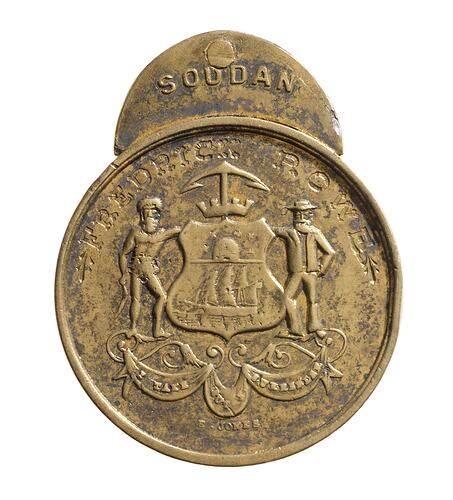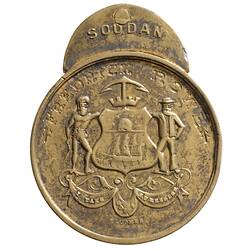Summary
Australia New South Wales Sydney
Mayor of Sydney Soudan medal 1885 (AD)
Mint: not recorded
Awarded to: Rowe, Fredrick
Medal issued by T. Playfair, Lord Mayor of Sydney. It was presented to each member of the contingent which fought in the Soudan, who were expected to engrave their own name, number or insignia on the medal.
Fredrick Rowe engraved his name on this medal. Rowe was born in St Georges, Somerset, England, in 1865. He moved to Australia some time in his youth, and became a labourer. He enlisted to fight in the first war to which colonial Australia had formally sent a force, the Soudan conflict. Rowe enlisted on 01/10/1883 at 18 years 11 months, and embarked on 03/03/1885. He returned to Australia on 23/06/1885 aboard the SS Arab. The Australian contingent in the Soudan sailed for home a mere 50 days after they had arrived. Australian casualties were few, and those who died fell to disease rather than enemy action. The contingent arrived in Sydney on 19 June. Five days later the contingent marched through the city to a reception at Victoria Barracks where they stood in pouring rain as the Governor, Lord Loftus, and the Premier gave speeches. It was generally agreed that, no matter how insignificant the military contribution by New South Wales, it marked an important stage in the development of colonial self-confidence and demonstrated the important of links with Britain.
Physical Description
Round metal with round arch at top and unpunched circle for a loop. Obverse depicts two figures either side of shield (one holding boomerang, the other dressed in a hat) with ship motif and inverted anchor above. Decorative ribbon depicted below. Reverse features wreath around central engraving, bordered by inscription.
Obverse Description
Round metal with round arch at top and unpunched circle for a loop. Obverse depicts two figures either side of shield (one holding boomerang, the other dressed in a hat) with ship motif and inverted anchor above. Decorative ribbon depicted below. On tab: SOUDAN; in ribbon: I TAKE BUT I SURRENDER; under ribbon E.JONES; engraved around top edge FREDRICK ROWE
Reverse Description
Reverse features wreath around central engraving, bordered by inscription.Around edge: PRESENTED BY THE CITIZENS OF SYDNEY. /T.PLAYFAIR.MAYOR,1885; within wreath, engraved: NSWA
Edge Description
Plain
Significance
In the early 1880s the British-backed Egyptian regime in the Sudan was threatened by a local rebellion led by Muhammed Ahmed, known to his followers as the Mahdi. In 1883 the Egyptian government sent an army south to crush the revolt. The Egyptians were soundly defeated, leaving their government with the problem of extricating the survivors. The British were persuaded to send General Charles Gordon, already heroic figure throughout the Empire, to determine a method by which the Egyptian troops could be safely withdrawn.
Gordon's enthusiasm for the task ran away with him, and instead of evacuating the troops he attacked the Mahdi. He soon found himself besieged in Khartoum. The English public was horrified by the predicament of the popular general, and a relief force was sent to Cairo in September 1884. It met stiff resistance and was still fighting its way up the Nile when Gordon was killed four months later. When word of his death was received in New South Wales loud recriminations were expressed against the Liberal government for having failed to act.
The Canadian government leapt into action and offered to send troops to the Sudan. Not to be outdone, the NSW government cabled London with its own offer, promising to meet the contingent's expenses. Britain accepted, but insisted that the contingent would be under British command. The news was received with great enthusiasm in New South Wales, marking the first time that soldiers in the pay of a self-governing Australian colony would fight in an imperial war.
On 3 March 1885 an infantry battalion of 522 men and 24 officers, and an artillery battery of 212 men, set sail. A public holiday was held to mark the occasion, described as the most festive ever seen in Sydney. Many people were hostile to the war, however, particularly in working-class suburbs and rural areas.
Twenty-six days later the contingent anchored at Suakin, Sudan's Red Sea port, and were attached to a brigade composed of Scots, Grenadiers and Coldstream Guards. They were immediately ordered to march in formation to Tamai, a village some 30 kilometres inland. The infantry reached Tamai almost without incident, burned some huts and returned to Suakin.
After Tamai, most of the NSW contingent worked on the railway line being laid across the desert towards the inland town of Berber on the Nile, half-way between Suakin and Khartoum. The artillery saw even less action than the infantry. They were posted to Handoub where they drilled for a month, then rejoined the camp at Suakin. Meanwhile the British government had decided to abandon the campaign, leaving only a single garrison in Suakin. The Australian contingent sailed for home on 17 May 1885, a mere 50 days after they had arrived. Australian casualties were few, and those who died fell to disease rather than enemy action.
The contingent arrived in Sydney on 19 June. Five days later the contingent marched through the city to a reception at Victoria Barracks where they stood in pouring rain as the Governor, Lord Loftus, and the Premier gave speeches. It was generally agreed that, no matter how insignificant the military contribution by New South Wales, it marked an important stage in the development of colonial self-confidence and demonstrated the important of links with Britain.
-Australian War Memorial web site http://www.awm.gov.au/atwar/sudan.htm.
-D. Tout-Smith 25/9/2003.
Cf. Car 1885/5, but just struck medal without frame, and gilt not silver.
More Information
-
Collecting Areas
-
Acquisition Information
Transfer from National Gallery of Victoria (NGV), 15 Mar 1976
-
Date Issued
1885 AD
-
Issued By
T. Playfair Lord Mayor of Sydney - City of Sydney, Sydney, Greater Sydney, New South Wales, Australia
Issued by T. Playfair, Mayor of Sydney -
Awarded To
Fredrick Rowe, Sydney, Greater Sydney, New South Wales, Australia
Has had his name engraved above the Arms on the obverse. -
Inscriptions
On tab: "SOUDAN"; in ribbon: " I TAKE BUT I SURRENDER"; under ribbon "E.JONES"; engraved around top edge "FREDRICK ROWE" Around edge: "PRESENTED BY THE CITIZENS OF SYDNEY. /T.PLAYFAIR.MAYOR,1885"; within wreath, engraved: " NSWA" (reverse)
-
Series
-
Material
Gilt
-
Axis
12
-
Classification
-
Category
-
Discipline
-
Type of item
-
Object Dimensions
27 mm (Width), 2.5 mm (Depth), 35 mm (Height), 27 mm (Outside Diameter), 11.79 g (Weight)
Height includes additional loop at top.
-
Shape
Round
-
References
Ca 1885/10
-
Keywords
Aboriginal Depictions, Siege of Khartoum, 1884-1885, Wars & Conflicts


